
TIBETAN MEDICINE
• gSo-ba-Rig-pa , as it is called in Tibetan, meaning "The Science of Healing", is one of the oldest surviving forms of ancient medical systems in the world and it has been practiced for the last 2500 years.
• For many centuries it has been successfully practiced in Tibet, China, Mongolia, the Buddhist regions of Russia and Central Asia, the Himalayan Kingdoms of Nepal, Sikkim, Bhutan, Ladakh and Northern India.
• Tibetan medicine is an ancient medical system that has its foundations embedded in
the teachings of Buddhist philosophy.
• Like Ayurveda, Tibetan medicine views illness as the result of imbalances in the biological rhythm.
• Tibetan medicine treatments include: herbal medicine, acupuncture, diet therapy, behavior therapy, massage, moxibustion, purification techniques, and religious rituals.
• Three principles of energy of the body are: Wind or Lung (Element is Air and it relates to respiration and movement), Bile or Tri-pa (Element is Fire and it relates to digestion, complexion, and temperament), Phlegm or Badken (Element is Earth and Water and it relates to sleep, joint mobility, and skin elasticity).
• Seven components of the body are milk, blood, meat, fat, bone, marrow, and essence.
• Three excretes of the body are excrement, urine, and perspiration.
AFRICAN MEDICINE
• African medicine is considered over 10,000 years old.
• The 5 elements in their order start with Fire, and then go as Water, and then move on to Earth, then to Mineral, and then Nature.
• Fire - red and it is the dream world. South is the direction.
• Water - blue or black and it is about reconciling. North is the direction.
• Earth - yellow and it is about nurturing, grounding, taking care of one another and unconditional love. Center is the direction.
• Mineral - white and it is about communicating, the ability to translate things, the ability to converse. West is the direction.
• Nature - green and it is about magic and major changes. East is the direction.
• Physicians are often priests, priestesses, or high priests.
• Disease is primarily understood as a disorder or misalignment of the internal or external milieu of the patient.
• African medicine uses divination, dream interpretation, traditional format of
questioning, observation and touching, dietary therapy, psychotherapy, surgery, and herbal medicine, exorcisms, rituals, sacrifices and other procedures which seem more the province of priests than physicians.
NATIVE AMERICAN MEDICINE
• Native American medicine is a historical collection of information, and treatment modalities of many different North American tribes, over thousands of years.
• The healing traditions of Native Americans have been practiced in North America since at least 12,000 years ago and possibly as early as 40,000 years ago.
• There are approximately 500 nations of indigenous people in North America, each representing a diverse wealth of healing knowledge, rituals, and ceremonies.
• Many aspects of Native American healing have been kept secret and are not written down.
• It is believed that sharing healing knowledge too readily or casually will weaken the spiritual power of the medicine.
• The most common methods include prayer, chanting, music, smudging or burning sage or aromatic woods, laying on of hands, dreaming, fasting, taking hallucinogens like peyote, counseling, sweat lodge and ceremonies.
• The hands are used to remove spiritual intrusions or to brush in healing powers.
• Cherokees warm their hands over coals and circle their palms either on or above an affected area.
• Some healers hold their hands to the front and back of an affected area.
• The offering of a gift ensures success of the treatment.
• The only gift that is required is a pouch of tobacco.
• Native Americans use dream catchers to catch their dreams.
• Their higher power is called the Great Spirit.
• Healing power can be inherited from ancestors, transmitted from another healer or developed through training.
• Shaman is a person who serves as an intermediary between humans and the supernatural world, using special powers to cure illness, foretell the future, etc.
• Medicine bundle is a leather bag or animal skin in which a Native American healer carries herbs, stones, and various ritual objects as a sign of his or her healing powers.
• Animals are very important to the Native Americans; they only kill what they will eat.
• Native Americans believe if they dream of an animal; that there is a meaning behind each animal.









